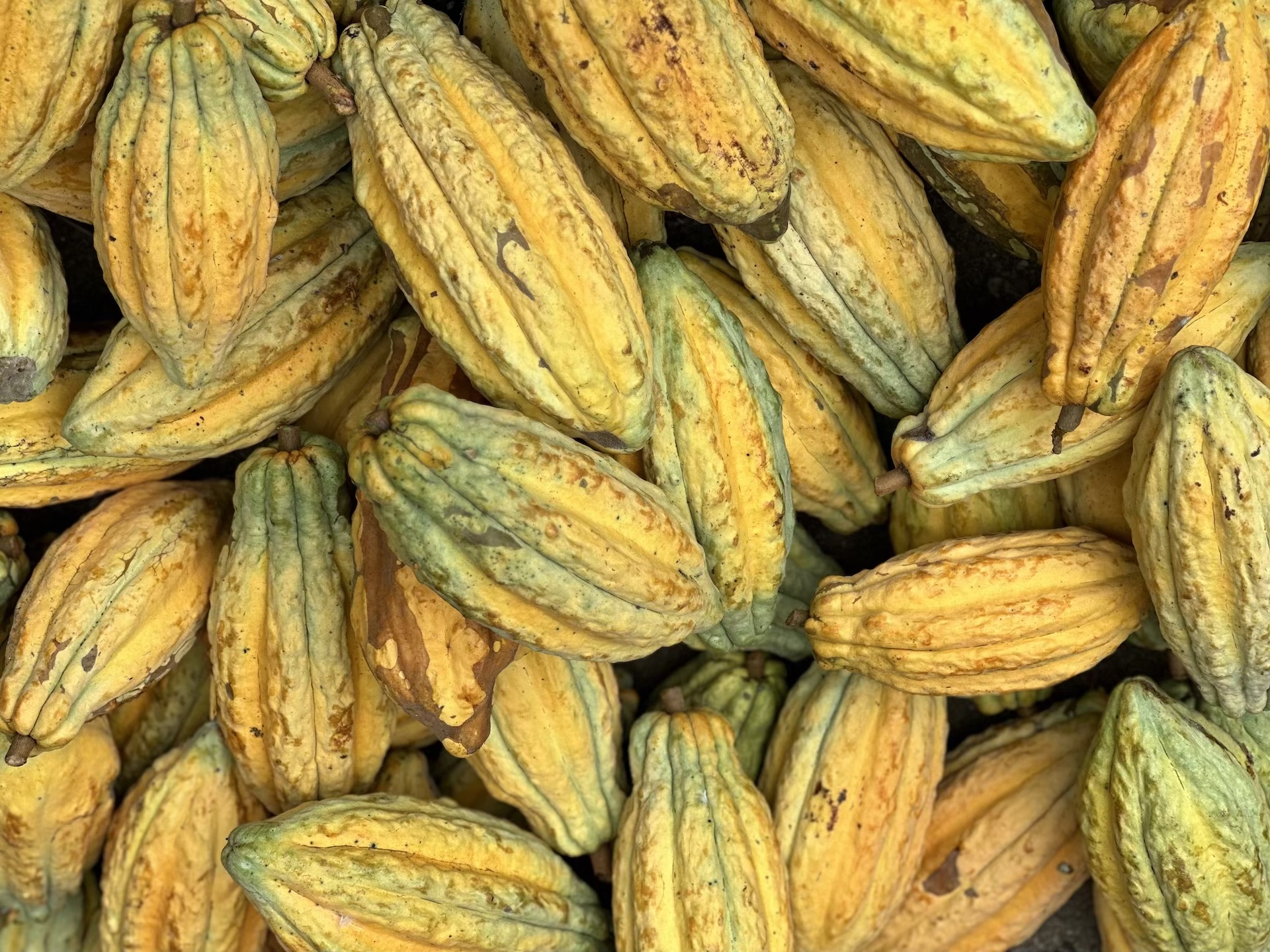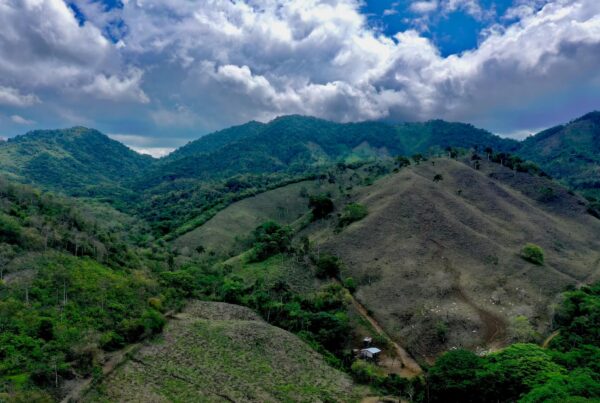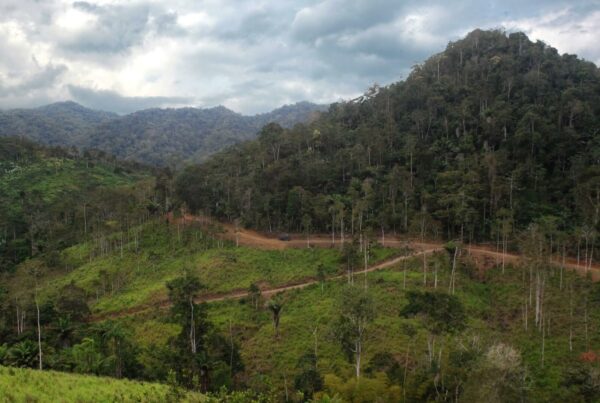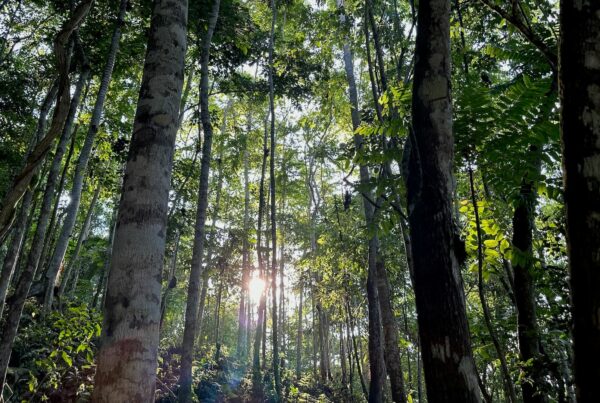Quick Summary
TMA has been experimenting with cacao varieties and growing methods since 2008. The Jama-Coaque Reserve currently contains the single largest repository of DNA-verified pure Ancient Nacional cacao in Ecuador. We actively manage 9 experimental cacao plots with 5 different types of Nacional cacao, and we closely track the genetics of every single plot. This is the same range of cacao varieties that TMA distributes to farmers throughout the Capuchin Corridor in our Regenerative Cacao program—featured in Smithsonian Magazine and Mongabay. In fact, the Jama-Coaque Reserve is the breeding ground for Capuchin Cacao. If you are a chocolate maker interested in sourcing cacao from this project, check out Capuchin Cacao.
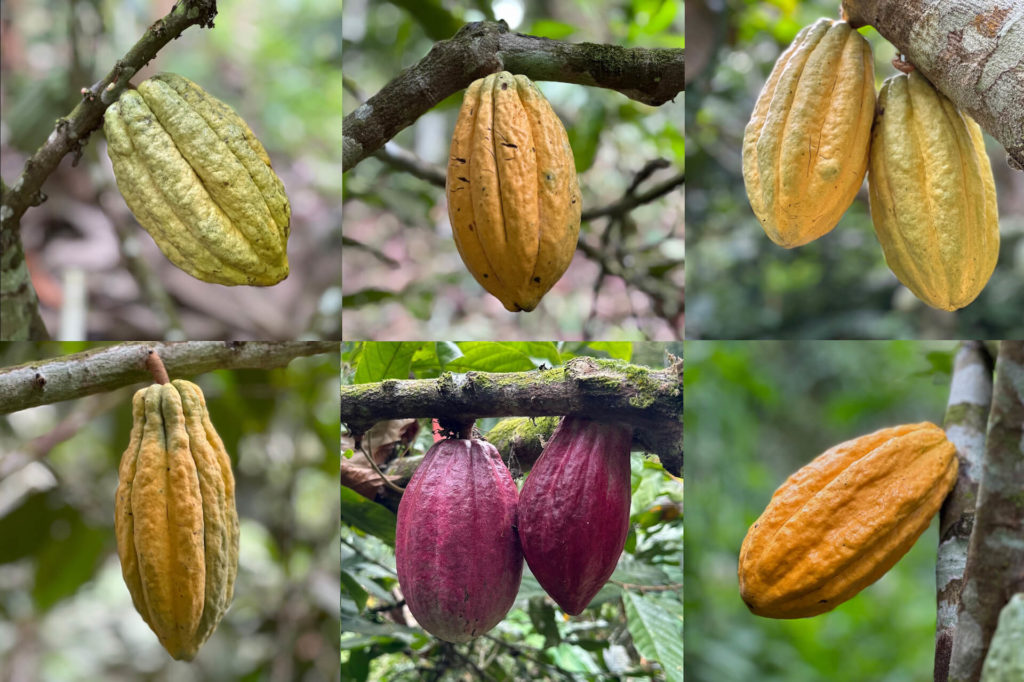
Top row: Ancient Nacional, Heirloom Nacional, and two Hybrid Nacional pods. Bottom row: Porcelana Nacional with Criollo influence, red Nacional Hybrids with Amelonado influence, and a slightly orangish Nacional Hybrid.
Introduction
TMA created a forest preserve in 2007 called the Jama-Coaque Reserve (pronounced Hama Ko-Ah-Kay). It protects one of the last remnants of the Pacific Forest of Ecuador—the most endangered rainforest on earth.
We started experimenting with cacao in the Jama-Coaque Reserve (JCR) in 2008. Our objective was to inform our reforestation efforts in the degraded land that surrounds JCR. Since that time, we’ve planted 9 experimental plots of cacao, each with different genetic profiles, different levels of shade coverage, and different irrigation and fertilizer regimes. Every single cacao plot is a polyculture of numerous tree species, including a combination of fruit trees and native canopy species—i.e., an agroforestry system. All are managed organically.
In addition to the experimental plots that we’ve planted ourselves, there are also four legacy cacao plots that were planted by previous owners many decades ago and later abandoned. These plots are now overgrown and effectively integrated into a secondary-growth forest, but we continue to monitor them as study plots. We’ve also taken DNA samples from these cacao groves and used them as seed sources for planting in our actively-managed plots.
The average size of each cacao plot is only 0.32 hectares. Collectively, all the above plots occupy 5.2 hectares (13 acres) of land, although only 3.5 hectares (8.6 acres) are actively managed. This represents 0.3% of the total area of JCR.
Our genetic data comes from three different rounds of DNA testing on cacao trees in both JCR and Piedra de Plata—thanks to a collaboration with To’ak Chocolate, the Heirloom Cacao Preservation Fund (HCP), the USDA Genetic Lab (under Dr. Lyndel Meinhardt and Dr. Dapenz Zhang), and the Cocoa Research Centre in Trinidad (under Dr. Lambert Motilal).
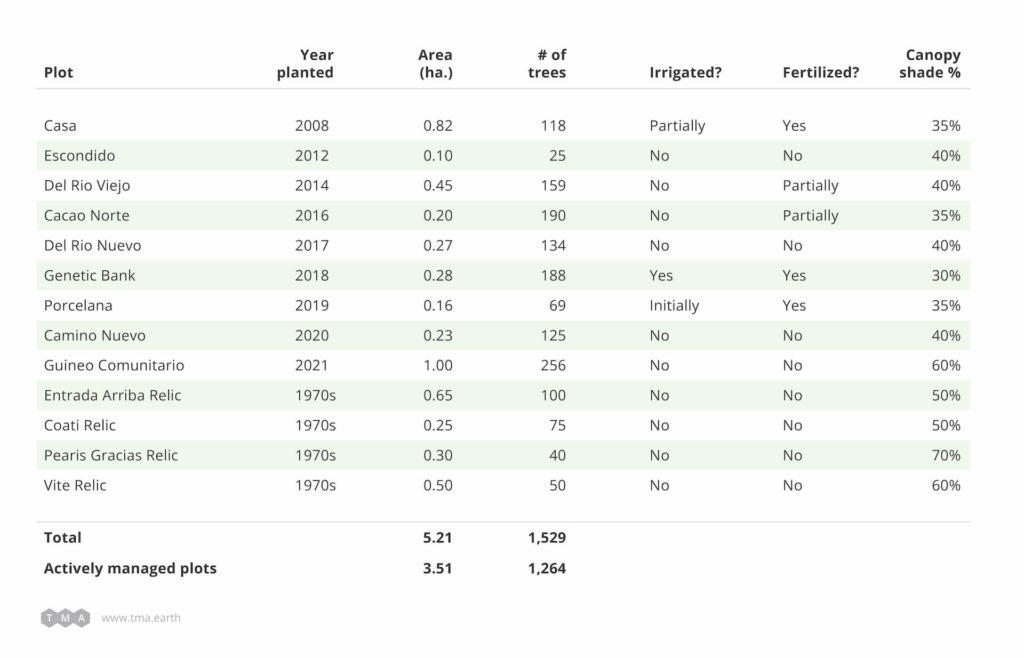
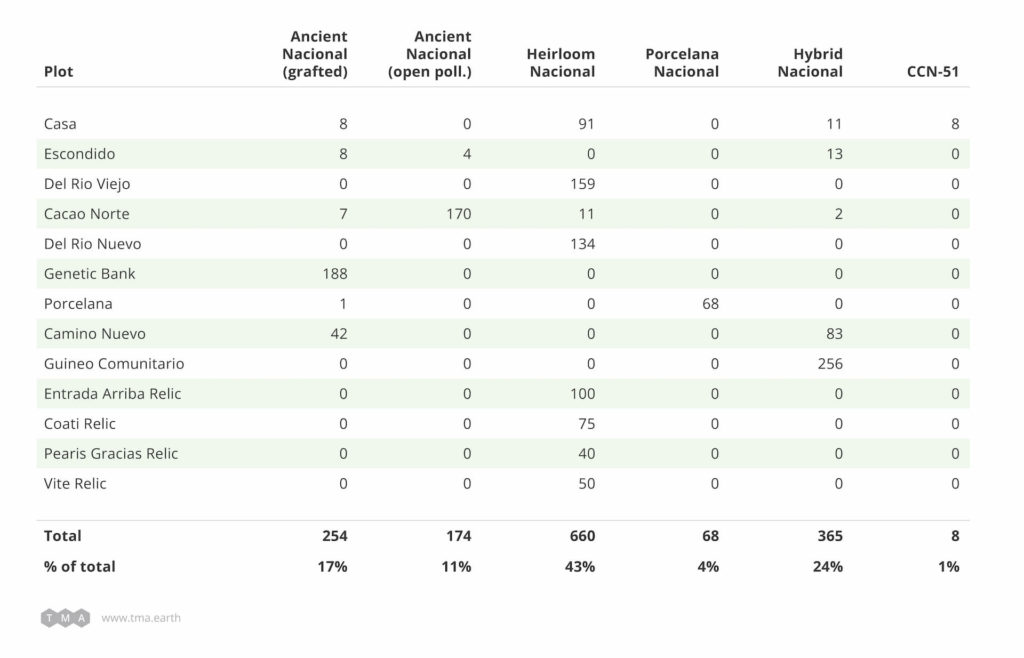
Quick Primer on Cacao Genetics
Before we get to the genetic composition of JCR cacao—and, by extension, Capuchin Cacao—here’s a quick primer on cacao genetics in general and Nacional cacao in particular.
The earliest evidence of cacao used by humanity dates back to 3300 BC in Ecuador, in the area now called Zamora-Chinchipe. From this general area it is believed that cacao then migrated to coastal Ecuador and presumably traveled northward as far as Mexico on ocean-faring rafts made of balsa wood—a tree that is native to the Pacific Forest of Ecuador and grows wild in JCR.
For most of the 20th century, cacao was crudely divided into three broad categories: Trinitario, Criollo and Forastero, the latter of which Nacional was clumsily considered a sub-category. In 2008, Juan Carlos Motamayor classified cacao into ten genetic clusters—i.e., primary varieties. The USDA and other genetic researchers have subsequently added one more. As of today, the list of primary varieties/genetic clusters includes:
- Nacional
- Amelonado
- Boliviano
- Contamana aka Ucayali/Scavina
- Criollo
- Curaray
- Guiana
- Iquitos aka Iquitos Mixed Calabacillo (IMC)
- Marañon aka Parinari
- Nanay
- Purús
These eleven “genetic clusters” are considered the primary varieties of cacao. It should be noted that Contamana, Curaray, IMC, Parinari, Nanay, and Purús are often collectively referred to as “Upper Amazon Forastero.” Amelonado is sometimes referred to as “Lower Amazon Forastero.”
Trinitario, a term commonly used in the past, is no longer considered a primary variety—per se. Rather, it is a hybrid of Criollo, Upper Amazon Forastero, and Amelonado.
In addition to these primary cacao varieties, there are countless hybrids and cultivars and the genetic profile of each of these varieties can now be determined through DNA testing. For example, the genetic composition of CCN-51, which is fast becoming the dominant cacao cultivar despite of its poor flavor reputation, is 45.4% IMC, 22.2% Criollo, 21.5% Amelonado, 3.9% Contamana, 2.5% Purús, 2.1% Marañon, and 1.1% Nacional.
“Fine Flavour” vs “Bulk” Cacao
From the International Cocoa Organization (ICCO): “The world cocoa market distinguishes between two broad categories of cocoa [aka cacao] beans: ‘fine flavour’ cocoa beans and ‘bulk’ or ‘ordinary’ cocoa beans.” It goes on to say that there are only three varieties/types of cacao that qualify as “fine flavour”: Nacional, Trinitario, and Criollo. The rest is generally considered “bulk” cacao. Ecuador is the largest producer of “fine flavour” cacao in the world. However, CCN-51 is classified as “bulk” cacao, and it is now the dominant cultivar in Ecuador…and spreading to other countries.
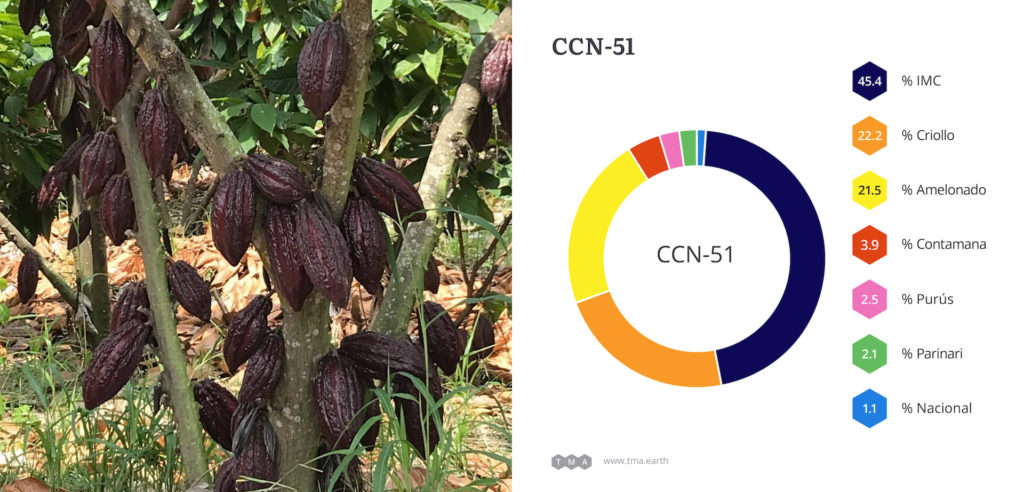
CCN-51 is the predominant “bulk cacao” variety in Ecuador. Only 1% of its genetic composition is Nacional.
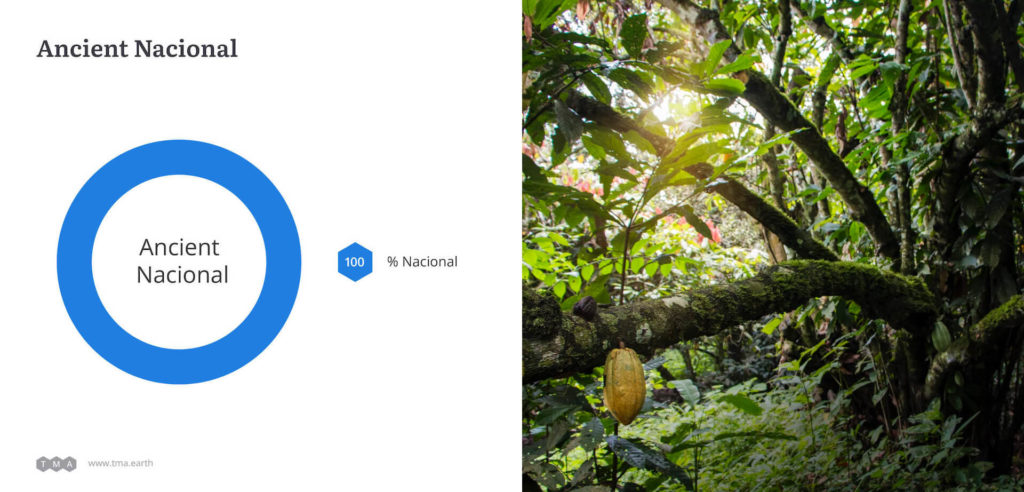
The USDA genetic lab uses the term “Ancient Nacional” to describe cacao trees with genetic composition of 100% pure Nacional. Pictured above is one of the 9 mother trees in Piedra de Plata, from which many of the trees in the Genetic Bank were reproduced. What you get in flavor, you sacrifice in yield.
Quick Primer on Nacional Cacao
The world’s most storied and coveted cacao variety is Nacional, which is endemic to Ecuador and the northeast tip of Peru. Older than written language in South America, Nacional emerged sometime between 3300 B.C.E. and the arrival of the first Spanish explorers—the exact provenance is still not known for certain.
In the 1800s, Europeans referred to Nacional as “Arriba”, which was a reference to its appellation at the headwaters of the Daule and Babahoyo rivers in coastal Ecuador. The floral aromatics and complex flavor profile of Nacional cacao was world-renown.
But after achieving global fame in the nineteenth century, Nacional cacao—in its purest form—was nearly lost in the twentieth century. The initial culprit was the back-to-back arrival of two fungal diseases (frosty pod and witch’s broom) in 1916 and 1919, respectively. A hundred years of hybridization with foreign varieties, and the widespread conversion to CCN-51, followed suit in Ecuador.
(I relay this historical account in great detail in an article published on To’ak’s website titled “The Near-Extinction of Ancient Nacional Cacao,” which includes citations to all source material.)
As a result, pure Nacional cacao was believed to be extinct as recently as 2009. Around this time, a small pocket of relic trees was found in the Marañon valley of Peru. And then in 2014, another pocket of relic trees was found in the valley of Piedra de Plata in coastal Ecuador, in the province of Manabí.
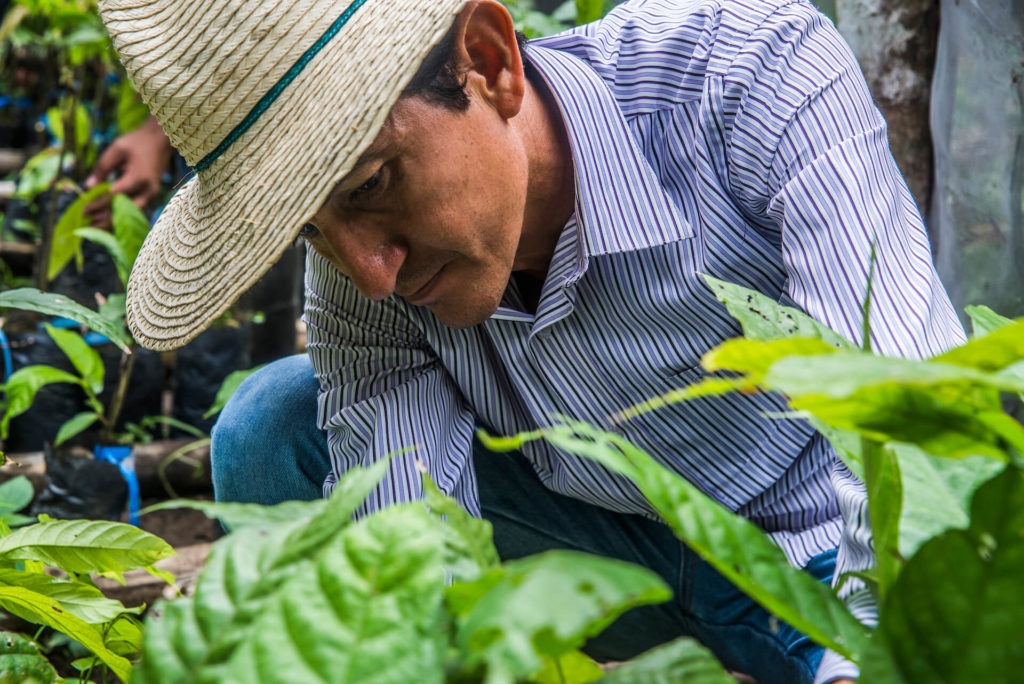
Servio Pachard observing pure Ancient Nacional cacao seedlings in the Jama-Coaque tree nursery in 2018.
The “Mother Trees” of Piedra de Plata
The discovery of Ancient Nacional cacao trees in Piedra de Plata was spearheaded by Servio Pachard, myself, and Carl Schweizer from To’ak Chocolate. It was later corroborated through genetic analysis by the USDA Genetic Lab, under the leadership of Dr. Lyndel Meinhardt and Dr. Dapenz Zhang, in partnership with the Heirloom Cacao Preservation Fund (HCP). Their analysis revealed that these trees were, in fact, 100% pure Nacional—which the USDA genetic lab termed “Ancient Nacional.”
As of 2015, there were only 15 cacao trees in all of Ecuador that were DNA-verified to be Ancient Nacional. Nine of these trees were in Piedra de Plata, all of which were already over one hundred years old and at the end of their expected lifespan.
In the years that followed, To’ak and TMA embarked on a project to pull this ancient cacao variety back from the brink of extinction. I first wrote about this project in 2018 in the (rather long-winded) article called The Noah’s Ark of Ancient Nacional Cacao. I provided in an update in 2020 in a more succinct article called Heirloom Cacao Conservation Timeline.
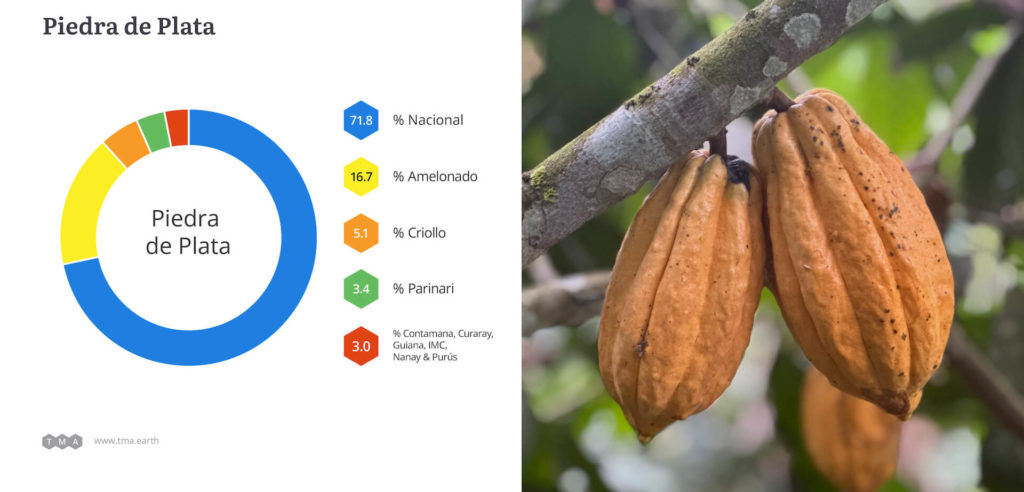
Left: The average genetic profile across all 47 tree samples analyzed in Piedra de Plata in the 2015 survey. Right: Cacao pods from a tree in JCR’s “Del Rio Viejo” plot, grown from an Heirloom Nacional seed sourced from Piedra de Plata.
The Genetic Bank (aka the “Noah’s Ark”)
The largest round of DNA testing in Piedra de Plata, sponsored by HCP and conducted by the USDA genetic lab, took place in 2015. They analyzed leaf samples from 47 trees, of which only 16 were old-growth trees that matched the characteristics of Ancient Nacional cacao. Out of these 16 old-growth cacao trees trees, nine of them were confirmed to be 100% Nacional.
(To’ak later performed a field survey of all 32,000 cacao trees in Piedra de Plata, under the guidance of Servio Pachard. This survey identified 573 trees that match the morphological and color characteristics of 100% pure Ancient Nacional cacao.)
With few Ancient Nacional trees still in existence, and all of them nearing the end of their lives—TMA and To’ak joined forces to preserve this historic variety of cacao. Our mission was to reproduce the nine DNA-verified mother trees in a protected parcel of land in JCR—an ecological reserve about 90 kilometers north of Piedra de Plata. The plot of land assigned for this task was a defunct banana grove that was cultivated by the previous landowner and then later abandoned.
To graft the trees, To’ak worked with the local cacao growers of Piedra de Plata along with cacao specialists from the provincial polytechnic university ESPAM, under the guidance of Ing. Paul Cedeño.
Budwood was collected from each of the nine DNA-verified trees in Piedra de Plata and grafted onto hundreds of young seedlings (i.e., “rootstock”). This is the same process used to reproduce grape vines of a specific variety (e.g., pinot noir) for wine production.
In March of 2018, a total of 189 grafted “Ancient Nacional” seedlings were planted in the appointed plot in JCR. Specifically, we planted twenty-one individual seedlings grafted from each of the nine DNA-verified mother trees (189 in total). We grandly referred to this parcel as the “Noah’s Ark of Ancient Nacional Cacao.” In practice, we simply call it the “Genetic Bank.”
That same year, the baby seedlings from the Genetic Bank got their first taste of media notoriety. A film crew from National Geographic’s “Explorer” series visited the Genetic Bank as part of a feature story about the future of the world’s cacao supply. More recently, the joint TMA-To’ak project was featured in the article The Quest to Save the World’s Most Coveted Chocolate in Smithsonian Magazine. Shortly thereafter it was featured in a fantastic article in Mongabay titled Can agroforestry chocolate help save the world’s most endangered rainforest?
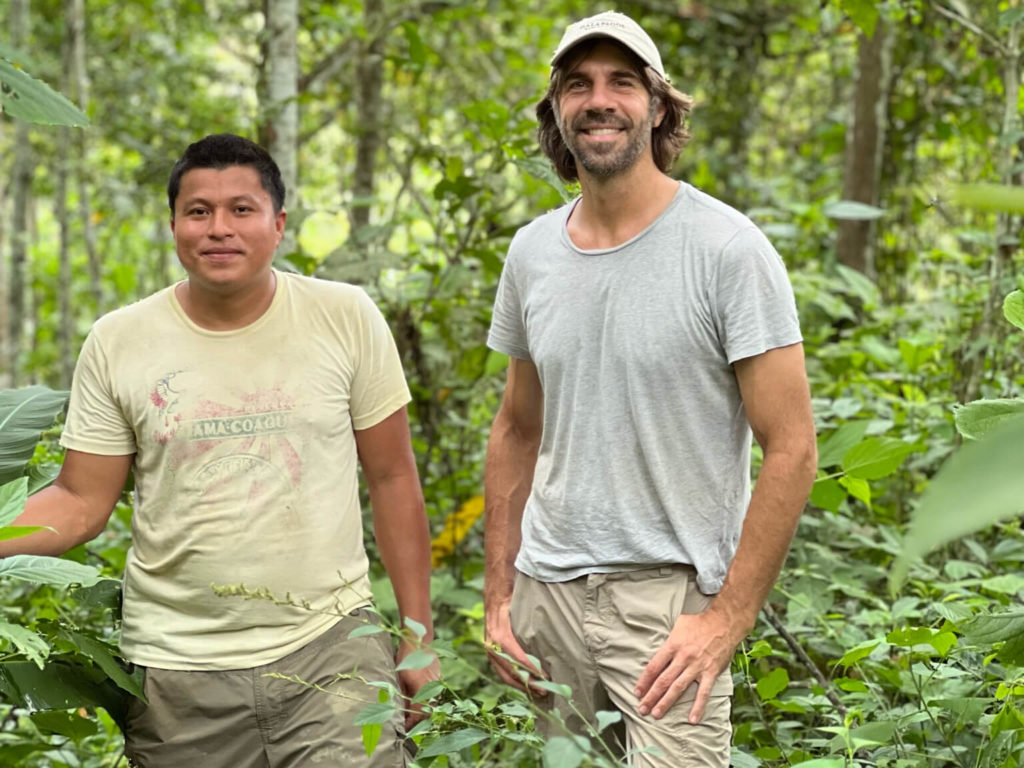
Dany Murillo (left) and Jerry Toth.(right) co-manage all of TMA’s cacao projects, including the Regenerative Cacao program.
Ancient Nacional vs Nacional Hybrids
As Nacional cacao suffered widespread casualties during the 1920s—owing to Frosty Pod and Witch’s Broom disease—foreign cacao seeds began to make their entrance into Ecuador, and a century of hybridization ensued. The foreign cacao varieties sexually paired with the remaining Nacional cacao trees through open pollination, producing offspring of mixed descent. Nacional was still the predominant variety of this next generation, but now other cacao varieties had also become part of the gene pool.
Thus, the first generation of Nacional hybrids were the result of open pollination. In the latter half of the 20th century, Ecuador’s agricultural research institute (INIAP) began a breeding program that crossed old Nacional relics (for the flavor) with hardier and more productive foreign varieties. The “EET” series of cultivars released by INIAP toward the end of the 20th century is the result of this breeding program. Most of these cultivars are 53-67% Nacional and contain lesser percentages of Criollo, Amelanado, Ucayali/Scavina, Curaray, IMC, Parinari, Nanay, and Purús.
For chocolate consumers out there, whenever you see a bar of chocolate that proclaims to be sourced from Nacional cacao, 99.9% of the time this means a Nacional hybrid. Unless it’s sourced from Piedra de Plata, Marañon, or—more recently, the Capuchin Corridor—it’s not Ancient Nacional.
Note: CCN-51—an ultra-high-yield variety with the reputation of poor flavor characteristics—is not a Nacional hybrid. It was developed by an independent Ecuadorian breeder and is only 1% Nacional.
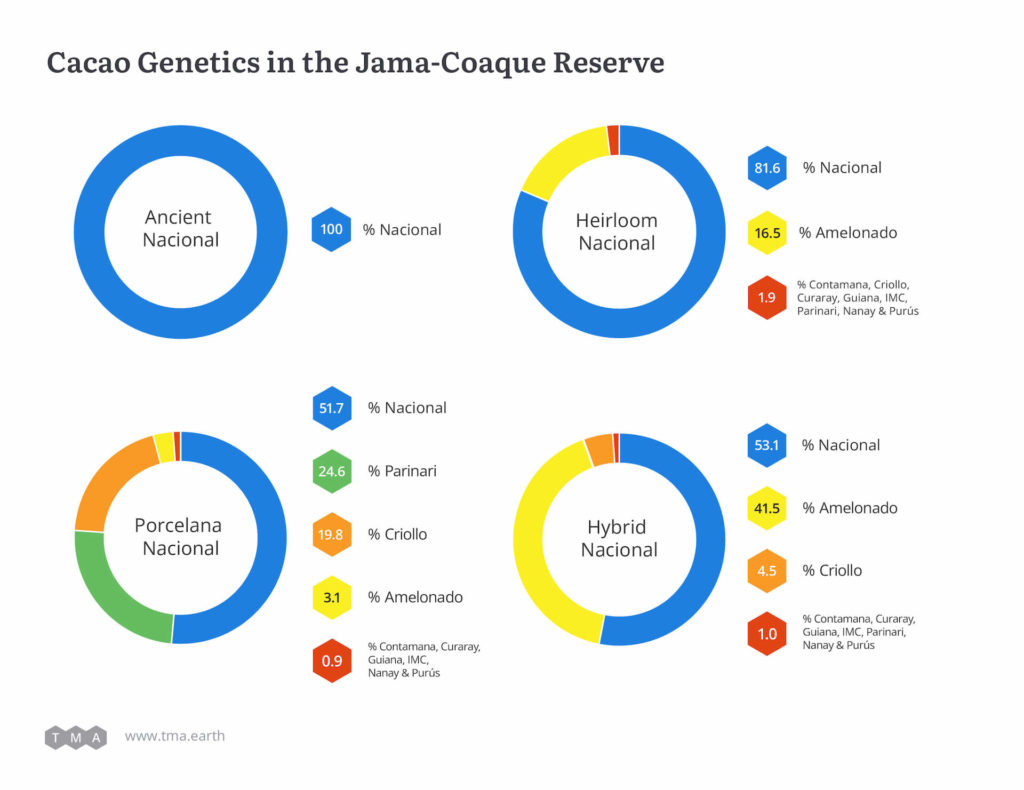
Nacional Cacao in the Jama-Coaque Reserve
The genetic composition of the cacao trees planted in JCR can be broken down into the following five categories.
Grafted Ancient Nacional: This refers to trees that were grafted from one of the nine DNA-verified Ancient Nacional cacao trees in Piedra de Plata. Each of these nine trees were cloned and then planted in various micro-plots of JCR—most prominently in the so-called Genetic Bank.
Open-pollinated Ancient Nacional: This refers to trees planted from the seed of one of the nine DNA-verified Ancient Nacional trees in Piedra de Plata. In this case, we know that the mother of these trees is 100% pure Ancient Nacional, but we don’t know the genetic profile of the father tree (i.e., the tree that provided the pollen that fertilized the flower on the mother tree). We sent leaf samples from one open-pollinated Ancient Nacional tree to the Cocoa Research Centre in Trinidad and the DNA analysis registered 93% Nacional, along with 3.5% Criollo, 1% Contamana, 1% Curaray, and less than 1% of Guiana, Iquitos, Parinari, Nacional, Nanay, Purús, and Amelonado.
Heirloom Nacional: Heirloom Nacional trees are the progeny of surviving Ancient Nacional trees that naturally hybridized with the initial wave of Trinitario cacao trees introduced to Ecuador during the decades following the 1916 disease outbreak and before the earliest release of INIAP’s relatively higher-yield Nacional” cultivars in 1978. Generally speaking, Heirloom Nacional trees are the result of a pure Nacional tree naturally breeding (i.e., through open pollination) with a tree that is a Nacional x Trinitario mix. The genetic composition is typically in the range of 70-99% Nacional, with the remaining genetic markers comprised of the many cacao varieties that comprise “Trinitario” cacao—namely Criollo, Amelonado, and Upper Amazon Forestero varieties such as Ucayali/Scavina, Curaray, IMC, Parinari, Nanay, and Purús. Based on what I’ve seen on the ground, in combination with what I’ve read in numerous scientific and technical papers and confirmed through conversations with veteran Ecuadorian cacao specialists at institutions like INIAP and ESPAM, I estimate that “heirloom” Nacional cacao represents approximately 5% of Ecuador’s current cacao production.
Hybrid Nacional (aka “Complejo Nacional”): This is usually the result of an heirloom Nacional tree breeding with another heirloom Nacional tree or other cacao cultivar—either naturally through open pollination or intentionally through controlled pollination by INIAP (Ecuador’s agricultural research institute). INIAP’s breeding programs are aimed at developing cacao cultivars that maintain the flavor characteristics of Nacional cacao while also being more resistant to diseases and generating relatively higher yields for farmers. This includes the “EET” class of cultivars that were bred by INIAP during the latter half of the 20th century. The genetic composition of these trees usually falls within the range of 40-70% Nacional. The Cocoa Research Centre in Trinidad analyzed the DNA of a few of our Hybrid Nacional trees in JCR and they ranged from 53-66% Nacional, with the remainder of genetic markers comprised of Trinitario varieties.
Porcelana (i.e. “White Bean”) Nacional: This is an interesting case. It has long been known that certain strains of cacao have a genetic mutation such that the interior of the seed (which is usually a deep purple color) is instead white. Porcelana Criollo cacao in Venezuela—another one of the most coveted cacao varieties on earth—is probably the most famous example of this. Shortly after we established the Genetic Bank in JCR, Servio Pachard told us about a cacao parcel in the Esmeraldas province with “white bean” Nacional cacao. I was skeptical but intrigued. Servio grafted about 50 seedlings and entrusted them to us. We planted them in a plot that we named—appropriately—”Porcelana.” In 2022, these trees produced their first fruits. And sure enough…we sliced open the seeds and the interior was white. We also sent a leaf sample from one of these trees to the Cocoa Research Centre’s genetic lab and it registered 52% Nacional, 20% Criollo, and 25% Marañon. Our hypothesis is that the “white bean” mutation comes from the Criollo side of the family. Interestingly, Nacional cacao and Criollo cacao are widely regarded to be the two best cacao varieties on earth. In an article on To’ak’s website, I compare the two.
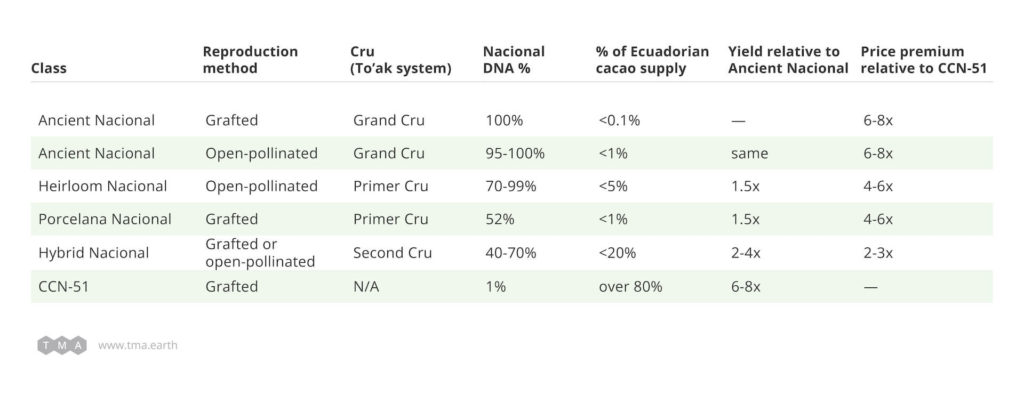 Regenerative Cacao
Regenerative Cacao
We’re using heirloom cacao trees to reverse deforestation and help restore a threatened rainforest in Ecuador. It’s an example of how businesses, conservationists, and local farmers can join forces to help regenerate the forest rather than cut it down.
Here’s how TMA’s Regenerative Cacao program works:
- Farmers plant a diverse mix of native shade trees, fruit trees, and heirloom cacao trees on degraded land.
- TMA provides all the materials and covers the start-up costs. This includes direct cash payments to farmers during the crucial transition period until their tree crops start producing income.
- Native shade trees remove CO2 from the atmosphere and boost biodiversity, while fruit trees and bananas provide local food security, and cacao trees provide a sustainable source of income for families.
- Chocolate makers like To’ak play a key role by paying farmers at least 3x more than the standard market price for the cacao, which includes DNA-verified Ancient Nacional cacao.
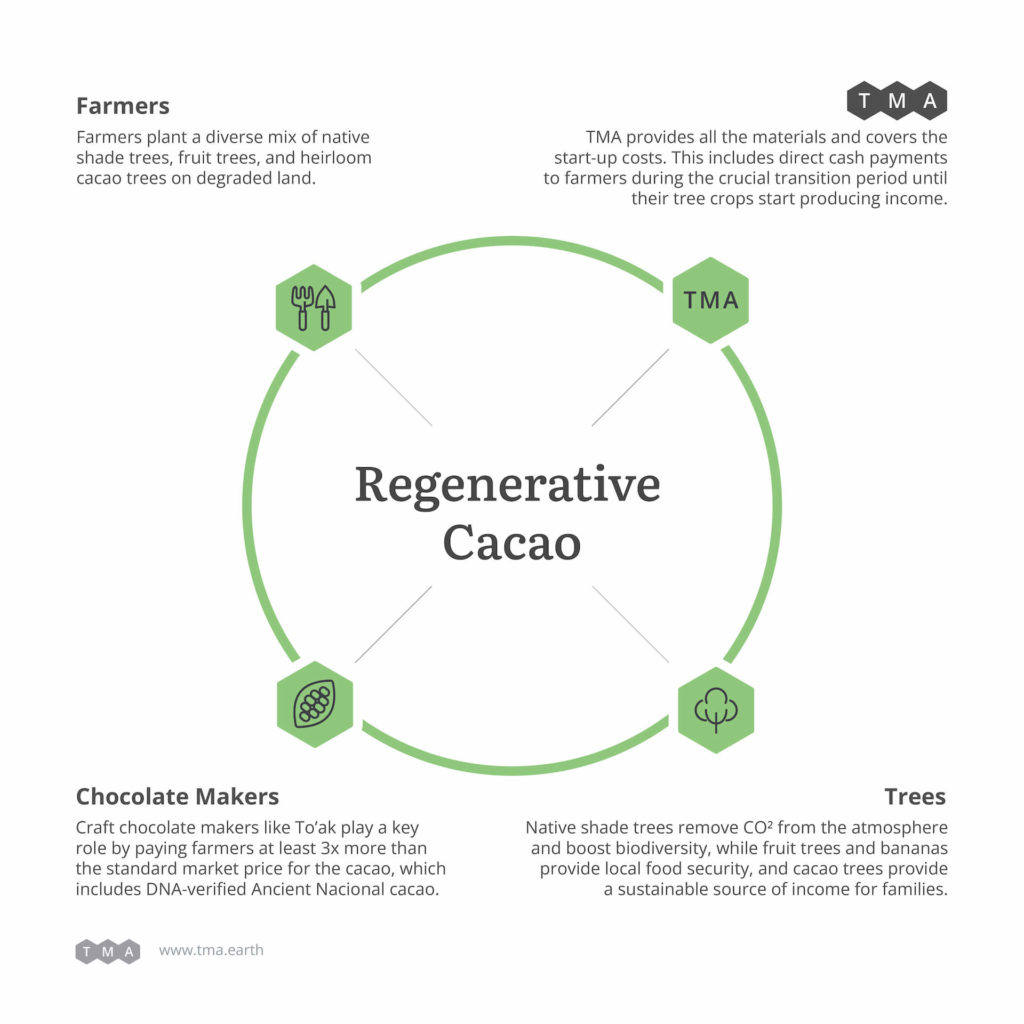
From Regenerative Cacao to Capuchin Cacao
TMA’s Regenerative Cacao program is specifically designed for cacao farmers who live in the Capuchin Corridor of coastal Ecuador. The Capuchin Corridor is a 40,000-hectare conservation corridor that aims to connect JCR with the chocó rainforests of Cerro Pata de Pájaro.
A total of 38 families enrolled in the Regenerative Cacao program in 2021-2022, and another 31 families enrolled in 2023. TMA’s goal is to include 100 families by 2025. TMA buys the cacao produced by all participating farmers and ferments and dries the cacao in the community adjacent to JCR. This cacao—which we call Capuchin Cacao—is then sold to To’ak and other interested craft chocolate companies.
Capuchin Cacao is a combination of Ancient Nacional (Grand Cru), Heirloom Nacional (Primer Cru), and Hybrid Nacional (Second Cru).
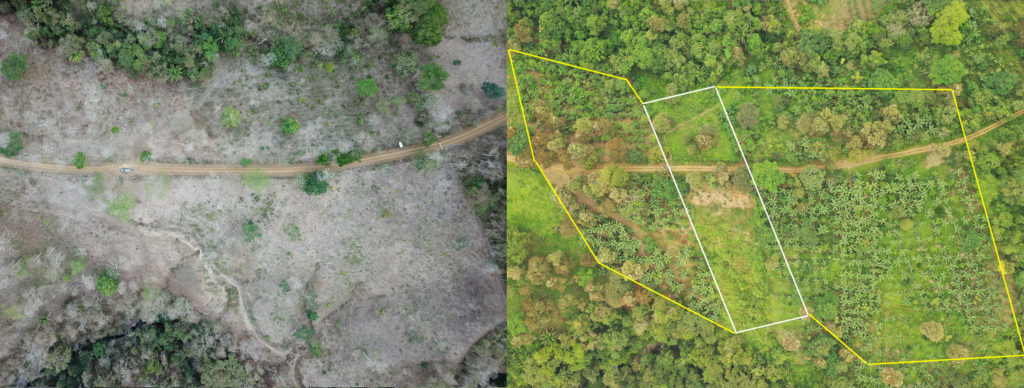
On the left, photo taken on December 29, 2020. On the right, photo of the same area taken less than 3 years later – on Sept 19, 2023. The land inside the yellow polygon are Regenerative Cacao parcels cultivated by the farmers in our program. The rectangle in white is the “control” polygon, owned by the one farmer in the area who did not want to participate in the program.
Onboarding New Chocolate Companies
If you represent a chocolate company that wants to be part of this project and source cacao from this origin, please fill out this form and we will get back to you. You can find more details about Capuchin Cacao, including pricing information, here.
And for a look at the appellation in which Capuchin Cacao is grown, observe the beautiful coastal Ecuadorian mountains of the Capuchin Corridor below. Cacao trees, combined with many other tree species, are planted in the deforested hillsides. From a conservation perspective, this serves three purposes:
- Replaces deforested land with productive and biodiverse food forests. These forests can help connect fragments of native forest, thus creating larger areas of contiguous wildlife habitat.
- Stimulating economic development at the base of the mountains reduces the need for people to illegally log and clear native forest along the tops of the mountains, where the watercourses are born.
- It’s an opportunity for conservationists, farmers, and businesses to work together for a common goal.
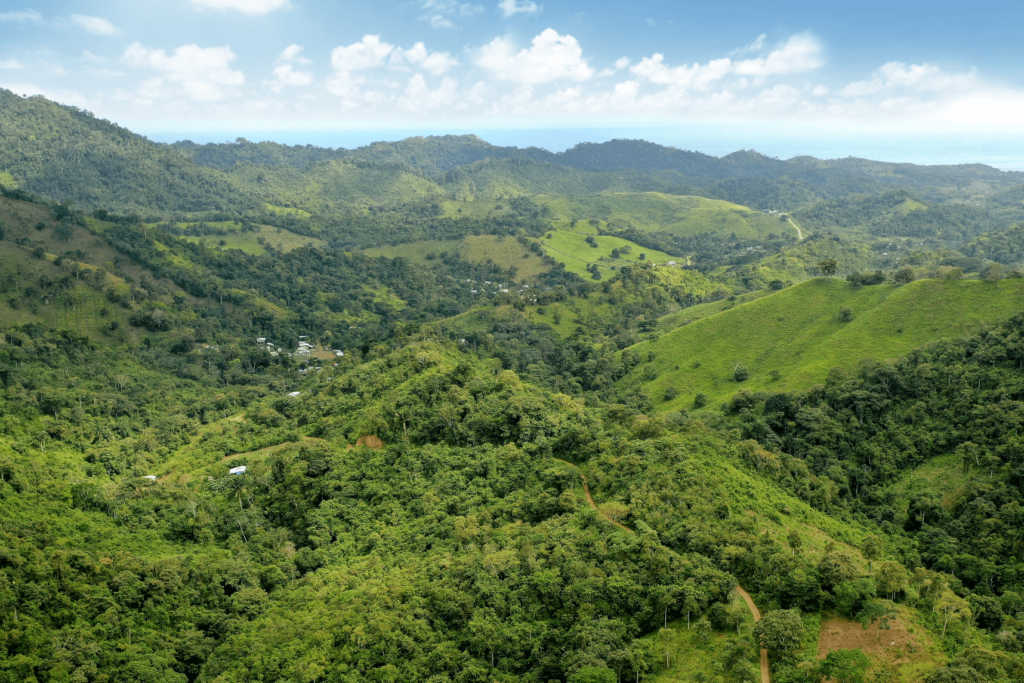
The partially-forested, partially deforested hillsides of the community of Camarones, a few kilometers downriver from the Jama-Coaque Reserve. TMA’s Regenerative Cacao program began here in 2021 and has since expanded to four other communities in the Capuchin Corridor.
